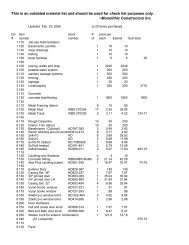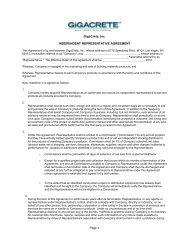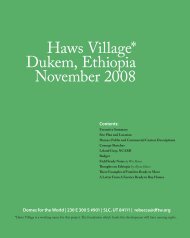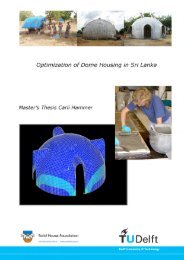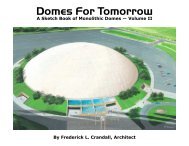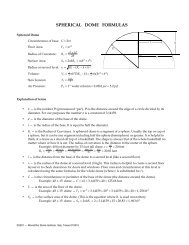Literature Review on Building Envelope, Heating and ... - Beeshive.org
Literature Review on Building Envelope, Heating and ... - Beeshive.org
Literature Review on Building Envelope, Heating and ... - Beeshive.org
Create successful ePaper yourself
Turn your PDF publications into a flip-book with our unique Google optimized e-Paper software.
3. <strong>Heating</strong>, Ventilati<strong>on</strong>, <strong>and</strong> Energy Technologies<br />
<strong>Heating</strong> <strong>and</strong> Ventilating<br />
HVAC Design C<strong>on</strong>siderati<strong>on</strong>s<br />
Meckler (1991) <strong>and</strong> Armstr<strong>on</strong>g (1993) discussed design challenges of HVAC in the arctic<br />
regi<strong>on</strong>s of Alaska <strong>and</strong> Canada. Armstr<strong>on</strong>g noted that the climate presents envir<strong>on</strong>mental<br />
challenges that must be recognized <strong>and</strong> addressed in every HVAC system design. The<br />
challenges result from extremes of cold, wind, snow, dry air, solar gain, <strong>and</strong> extended<br />
darkness.<br />
Climate Challenges: Alaska<br />
• <strong>Heating</strong> degree days range from 6697 heating degree days (base 65°F) in Ketchikan<br />
(at 55º 21 N´ latitude) to 20 341 heating degree days (base 65°F) in Barrow (at 71º 18<br />
N´ latitude).<br />
• Snowfall varies greatly in Alaska.<br />
• Temperate coastal communities (e.g., Ketchikan) have an average annual snowfall of<br />
94 cm (37 in.) <strong>and</strong> little accumulati<strong>on</strong> over a few days.<br />
• South central <strong>and</strong> northern communities (e.g., Valdez) receive large quantities of<br />
snow; an average annual snowfall is 625 cm (246 in.) with a record snowfall in excess<br />
of 1524 cm (600 in.). Snow accumulates for most of the winter, <strong>and</strong> compacts to a<br />
depth of about 4 m (12 ft.).<br />
• Low temperatures can range from -57ºC (-70ºF) for weeks in interior areas to<br />
-34ºC (-30ºF) in south central <strong>and</strong> western areas <strong>and</strong> last for extended periods.<br />
Temperatures can reach 35ºC (95ºF) in summer. There is very little temperature<br />
swing from night to day during the winter m<strong>on</strong>ths when there is little or no sun.<br />
• Wind speeds in excess of 200 km/h (125 mph) are comm<strong>on</strong>. The coastal areas are<br />
subjected to storms with hurricane force winds.<br />
• Summer days are l<strong>on</strong>g, particularly north of the Arctic Circle where the sun rises in<br />
the early summer <strong>and</strong> stays until fall. C<strong>on</strong>tinuous sunshine poses special challenges in<br />
dealing with solar gain that does not subside during the night.<br />
HVAC Design C<strong>on</strong>siderati<strong>on</strong>s<br />
Meckler (1991) noted that design c<strong>on</strong>siderati<strong>on</strong>s for the arctic regi<strong>on</strong> differ from<br />
temperate climates <strong>and</strong> require greater attenti<strong>on</strong> to c<strong>on</strong>densati<strong>on</strong> <strong>on</strong> building envelope<br />
surfaces <strong>and</strong> glazing. In some areas, the moisture c<strong>on</strong>tent of the outdoor air is almost zero<br />
for several m<strong>on</strong>ths of the year, <strong>and</strong> heating without adequate humidificati<strong>on</strong> can result in<br />
an unacceptable indoor humidity level. Design of HVAC systems in such regi<strong>on</strong>s<br />
requires modificati<strong>on</strong>s to the comm<strong>on</strong> design methods used in temperate climates<br />
PERD-079: Task 2 - <str<strong>on</strong>g>Literature</str<strong>on</strong>g> <str<strong>on</strong>g>Review</str<strong>on</strong>g> 79



